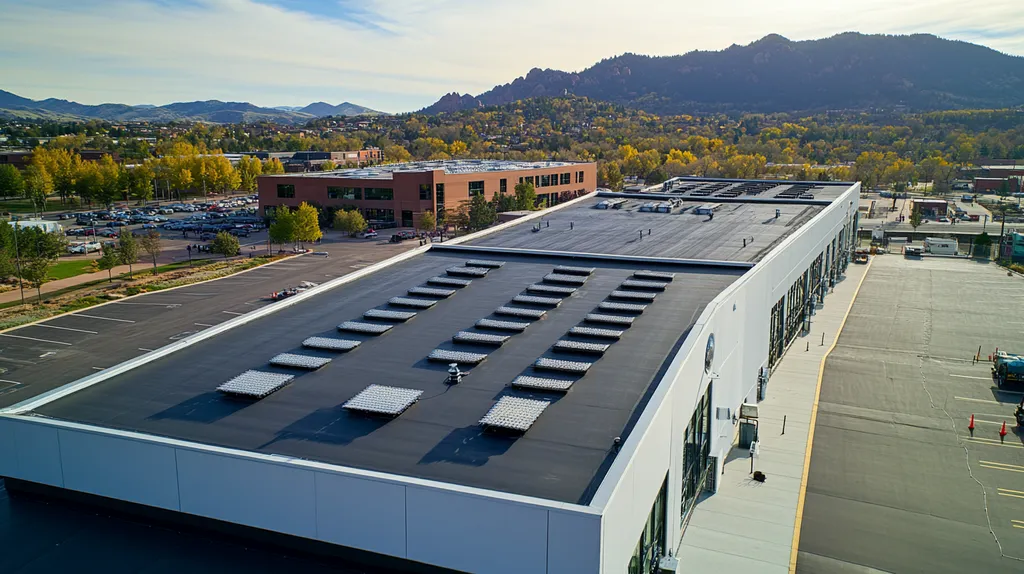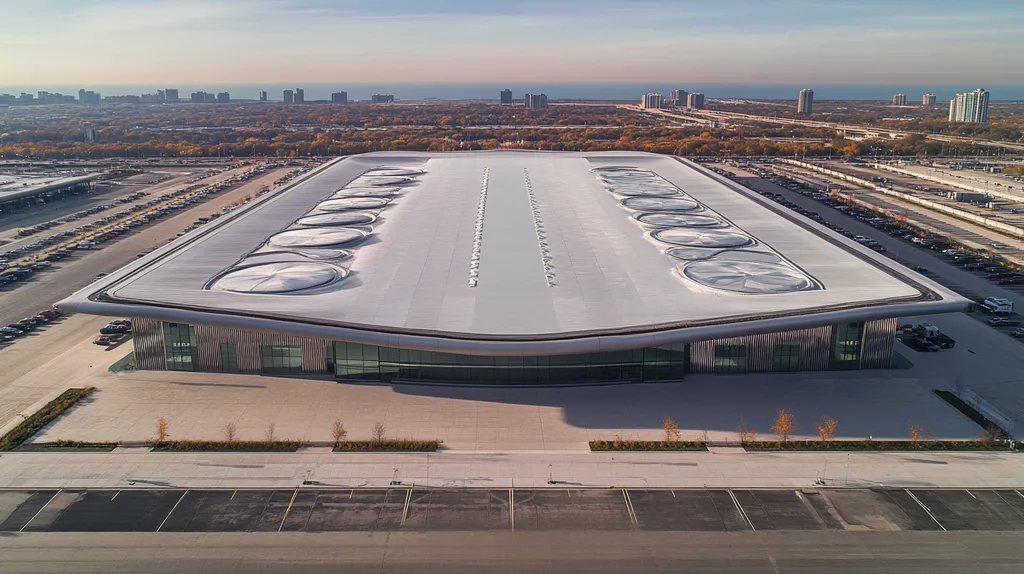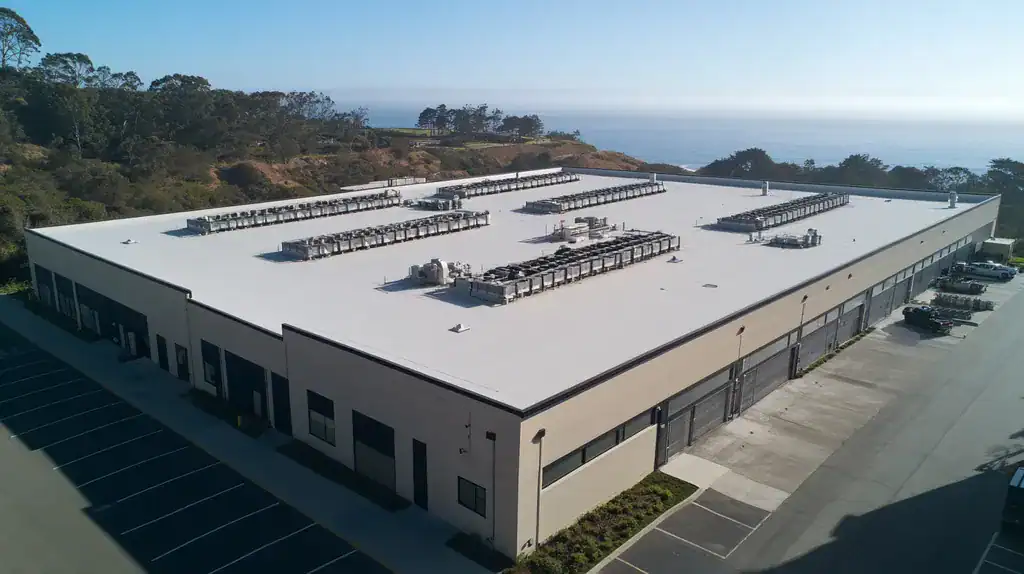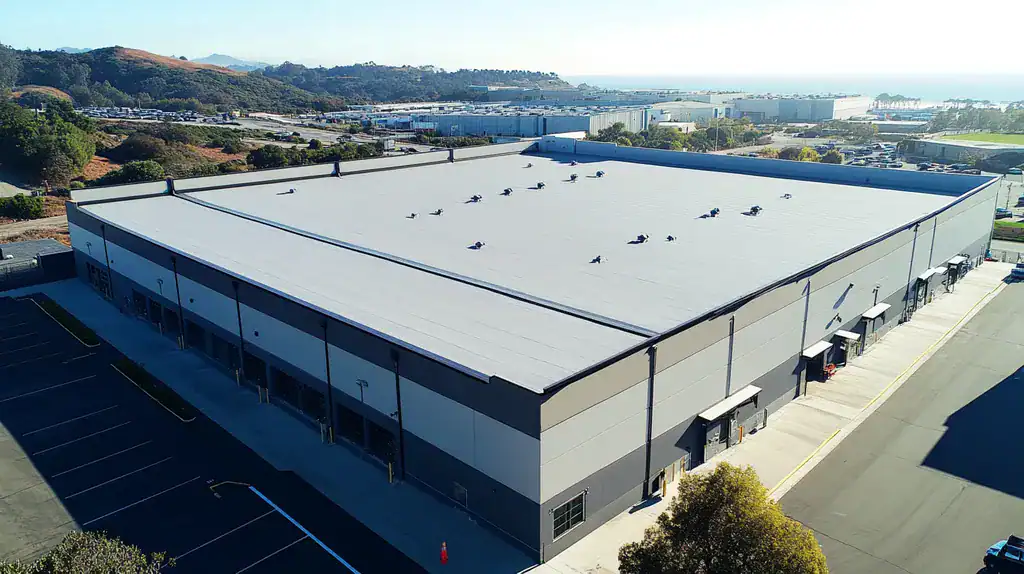Every year, industrial facilities lose millions in productivity due to poorly planned roof coating projects. Industry data shows that up to 40% of coating applications cause unnecessary operational disruptions that could be prevented.
Modern coating technologies and strategic planning can reduce facility downtime by up to 85% while extending roof life by 10-15 years. However, success requires understanding key factors like material selection, application timing, and coordination with facility operations.
This guide examines proven strategies for minimizing business interruption during industrial roof coating projects, from initial assessment through final inspection.
SECTION 1: THE BASICS EXPLAINED
Industrial roof coating projects represent a critical investment in facility infrastructure, with the potential to extend roof life by 10-15 years while maintaining daily operations. Recent industry data shows that properly applied coatings can reduce energy costs by up to 30% and prevent costly water damage that affects nearly 40% of commercial buildings annually. Understanding the fundamentals of roof coating helps facility managers make informed decisions that protect both their buildings and bottom line.
What It Is (In Plain Language)
A roof coating system is essentially a fluid-applied layer that creates a seamless, protective barrier over your existing industrial roof. Think of it as a durable shield that guards against water, UV rays, and temperature fluctuations.
Industrial waterproofing coatings create a tight seal against moisture intrusion while offering quick application times compared to traditional roof replacement. The coating can be applied efficiently, reducing project timelines and minimizing operational disruptions. (source: Performance Painting)
Modern coating systems come in several varieties, including acrylic, silicone, and polyurethane. Each type offers specific advantages depending on your roof type, climate conditions, and facility requirements.
These coatings form a renewable surface that can be reapplied periodically, extending roof life without the need for complete replacement. This approach preserves the existing roof structure while adding protective qualities.
Why It Matters (To Your Building)
The primary benefit of roof coating lies in its ability to prevent costly structural damage while maintaining continuous operations. A single roof leak can damage expensive equipment, disrupt production, and create safety hazards.
Coating systems provide excellent waterproofing protection while reflecting up to 85% of solar heat. This reflection capability can reduce cooling costs significantly, especially in facilities with large roof areas.
Modern coatings also help facilities meet current energy codes and environmental standards. Many systems qualify for ENERGY STAR certification and can contribute to LEED points.
Regular coating maintenance extends roof life at a fraction of replacement cost. This preservation strategy helps avoid the extensive demolition, waste, and disruption associated with complete tear-offs.
How It Works
The coating process begins with thorough inspection and surface preparation. Technicians clean the roof surface and repair any existing damage to ensure proper coating adhesion.
Application methods vary by coating type but typically involve spray or roller application in multiple passes. Modern equipment ensures even coverage and proper mil thickness for maximum durability.
Weather conditions play a crucial role in application timing. Ideal conditions include dry surfaces, moderate temperatures, and low humidity for proper curing.
Most coating systems can be applied while the building remains operational. Careful project scheduling and containment procedures prevent disruption to facility activities.
Regular inspections and maintenance after application help maximize coating performance. Small touch-ups can address wear points before they become significant issues.
SECTION 2: PRACTICAL APPLICATIONS
Industrial roof coating applications represent a critical investment in facility resilience, with improper timing or implementation leading to costly disruptions. Recent data shows that proactive coating projects can reduce emergency repairs by up to 85% while extending roof life by 10-15 years. Understanding when and how to apply coatings, along with their interaction with building systems, helps facility managers maximize protection while minimizing operational impact.
Common Uses & Examples
Industrial roof coatings serve multiple purposes across manufacturing, warehousing, and cold storage facilities. Their primary function is creating a seamless, protective barrier against UV radiation, moisture infiltration, and thermal stress.
Food processing plants and pharmaceutical facilities often utilize specialized antimicrobial coatings that prevent bacterial growth while maintaining strict environmental controls. These coatings help facilities meet FDA and USDA requirements without production interruptions.
Distribution centers with large roof areas benefit from reflective coatings that reduce cooling loads by up to 30%. This energy efficiency improvement directly impacts operational costs while extending HVAC equipment life.
Chemical processing facilities rely on chemical-resistant coatings to protect against corrosive emissions and maintain structural integrity. These specialized applications prevent degradation that could compromise safety and production.
When You Need It Most
Timing is crucial for successful coating applications. The ideal window occurs when existing roofs show early signs of aging but before significant deterioration occurs.
Buildings experiencing increased energy costs or minor leaks should prioritize coating applications. Early intervention prevents these issues from escalating into major disruptions requiring extensive repairs.
Facilities planning expansions or equipment upgrades should incorporate coating projects into their timeline. This coordination prevents multiple disruptions and ensures comprehensive protection of new investments.
Weather patterns play a vital role in application timing. Planning around seasonal conditions ensures proper curing and maximizes coating performance.
Interactions With Other Systems
Roof coatings must integrate seamlessly with existing building systems to ensure maximum effectiveness. Design considerations should emphasize resilience and uninterrupted operations during extreme circumstances. (source: Government of Alberta Infra Technical Design Requirements)
HVAC systems require particular attention during coating projects. Proper coordination prevents coating fumes from entering air handling units while maintaining indoor air quality.
Lightning protection and safety equipment must remain functional throughout the coating process. Temporary measures ensure continuous protection while allowing complete coverage.
Drainage systems impact coating performance and longevity. Proper slope and drainage patterns prevent ponding water that could degrade the coating prematurely.
SECTION 3: KEY TERMINOLOGY DECODED
Clear communication during industrial roof coating projects can mean the difference between seamless execution and costly delays. When facility managers and contractors misalign on terminology, projects often require rework, extending disruption to operations. Research shows that miscommunication accounts for nearly 30% of coating project delays, making a thorough understanding of roofing terms essential for maintaining business continuity.
Essential Terms Explained
The “substrate” forms the foundation of any coating project, representing the existing roof surface that will receive the coating. Understanding your substrate type determines preparation methods, coating selection, and application techniques.
Roof coating projects require careful attention to “adhesion” – the molecular bond between coating and substrate. Poor adhesion leads to coating failure, requiring disruptive repairs or premature recoating.
“Flash points” refer to areas where the roof meets walls, equipment mounts, or other vertical surfaces. These critical junctions require special attention during coating to prevent water infiltration.
“Mil thickness” indicates the coating’s depth measurement, with each mil representing 1/1000th of an inch. Proper mil thickness ensures adequate protection while avoiding material waste.
Industry Jargon Translated
“Recoat window” defines the optimal timeframe for applying additional coating layers. Missing this window necessitates extensive surface preparation, extending project duration and facility disruption. (source: Draper Construction)
“Green time” indicates how long a coating remains workable after mixing. Understanding this prevents material waste and application defects that could require disruptive corrections.
“Surface profile” describes the microscopic peaks and valleys in the substrate. Proper profiling ensures optimal coating adhesion and long-term performance.
“Cure time” represents the period needed for complete coating hardening. This affects facility operations scheduling and protection requirements during the curing phase.
Measurement & Units Simplified
“Coverage rate” indicates how many square feet one gallon of coating will protect at a specified thickness. Accurate coverage calculations prevent material shortages that could halt project progress.
“Tensile strength” measures the coating’s resistance to breaking under stress, expressed in pounds per square inch (psi). Higher tensile strength typically indicates better durability and longer service life.
“Solar reflectance index” (SRI) quantifies how well a coating reflects solar heat, measured on a scale of 0-100. Higher SRI values translate to greater cooling cost savings.
“Viscosity” determines how easily the coating flows during application, measured in centipoise (cP). Proper viscosity ensures even coverage and reduces application time.
SECTION 4: DECISION FACTORS
Industrial roof coating decisions directly impact operational continuity and long-term facility costs. Recent market analysis shows that poorly chosen coating systems lead to 40% higher maintenance expenses and triple the frequency of production interruptions. Making informed choices about materials, application methods, and timing can mean the difference between seamless operations and costly shutdowns. Understanding key decision factors helps facility managers protect both their buildings and bottom line.
Cost Considerations
Roof coating projects represent significant capital investments that must balance immediate budget constraints with long-term performance requirements. Quality coating materials typically account for 30-40% of project costs, with application labor comprising the remainder.
While premium coatings command higher upfront costs, they often deliver superior protection and longer service life. Value analysis should consider not just material costs, but also potential savings from reduced energy consumption and extended maintenance intervals.
Roof coating projects offer substantial cost advantages compared to full roof replacement, with minimal disruption to daily operations. Proper coating selection and application can defer expensive tear-offs while maintaining facility productivity. (source: Draper Construction)
Life-cycle cost analysis should include factors like warranty coverage, maintenance requirements, and energy savings potential. This comprehensive approach helps justify investment in higher-quality coating systems.
Performance Trade-offs
Different coating types offer varying levels of protection against specific environmental challenges. Silicone coatings excel at moisture resistance but may attract dirt, while acrylics provide excellent UV protection but less ponding water resistance.
Application thickness affects both performance and cost. Thicker coatings provide enhanced protection but require longer cure times and higher material costs.
Climate conditions significantly influence coating selection. Hot climates benefit from highly reflective coatings, while facilities in areas with frequent rainfall need superior waterproofing properties.
Chemical exposure from facility operations or environmental factors requires specialized coating formulations. These performance requirements must be balanced against application constraints and cure times.
Lifespan & Durability Factors
Coating durability directly correlates with substrate preparation quality and application conditions. Proper surface cleaning and priming can extend coating life by 50% or more.
Environmental stressors like UV exposure, temperature cycling, and chemical exposure impact coating longevity. Selecting materials engineered for specific exposure conditions helps maximize service life.
Regular maintenance inspections can identify wear patterns and potential failure points before they impact operations. Early intervention with spot repairs prevents more extensive coating failures.
Warranty terms should align with facility maintenance schedules and expected service life. Understanding coverage limitations helps facilities plan for future recoating or replacement needs.
SECTION 5: COMMON CHALLENGES
Industrial roof coating projects present a complex array of challenges that can significantly impact facility operations and project success. Industry data shows that unaddressed coating issues lead to 40% higher maintenance costs and extended production interruptions. Without proper planning and expertise, common problems like weather delays, material compatibility issues, and improper application can transform a straightforward maintenance project into a costly operational disruption.
Frequent Problems & Solutions
Weather-related delays represent the most common challenge in coating projects. Temperature fluctuations, humidity levels, and precipitation can halt application progress and affect cure times.
Surface preparation issues frequently compromise coating performance. Improper cleaning, insufficient repairs, or inadequate priming can lead to adhesion failures that require extensive rework.
Industrial roof coatings can be applied quickly while maintaining building access, providing a cost-effective alternative at approximately 25% of full replacement costs. This approach minimizes tenant disruption while delivering decades of protection. (source: Unicoat Roofing)
Material compatibility problems between existing roofing and new coatings can cause immediate or delayed failure. Comprehensive testing and proper material selection prevent these costly issues.
Warning Signs To Watch For
Blistering or delamination in existing coatings indicates moisture trapped beneath the surface. These conditions require immediate investigation to prevent widespread coating failure.
Ponding water that remains for more than 48 hours suggests drainage issues. Addressing these problems before coating application prevents premature degradation.
Substrate movement or building settlement can create stress points in coating systems. Regular inspection of these areas helps identify potential failure zones early.
Changes in facility operations that increase chemical exposure or roof traffic may compromise coating performance. Monitoring these factors enables proactive maintenance planning.
Preventative Approaches
Comprehensive roof surveys before coating application identify underlying issues that could affect performance. This evaluation prevents unexpected repairs during project execution.
Establishing clear quality control procedures ensures consistent application thickness and proper cure times. Regular monitoring prevents shortcuts that compromise long-term performance.
Developing detailed project schedules that account for weather windows and facility operations minimizes disruption. This coordination prevents costly work stoppages and maintains productivity.
Creating maintenance protocols for coated roofs extends service life and prevents premature failure. Regular inspections catch minor issues before they require extensive repairs.
SECTION 6: NEXT STEPS & RESOURCES
Successful industrial roof coating projects require careful planning, expert guidance, and ongoing education to minimize operational disruptions. Industry data shows that facilities lacking proper preparation experience 45% longer project timelines and face up to three times the operational downtime. Understanding how to evaluate providers, navigate standards, and access learning resources helps facility managers maintain productivity while protecting their roofing investments.
Questions To Ask Providers
Roof coating projects can be completed with minimal impact on daily operations when properly managed. Coating applications typically cause significantly less noise, dust, and downtime compared to full roof replacement projects. (source: Draper Construction)
Request detailed explanations of containment procedures and scheduling strategies. Quality providers will outline specific measures to protect facility equipment and maintain air quality during application.
Verify experience with your specific roof type and coating system. Ask for documentation of similar projects, including timeline adherence and disruption mitigation strategies.
Examine their quality control processes and inspection protocols. These should include moisture testing, adhesion verification, and thickness monitoring throughout application.
Review their communication protocols and emergency response capabilities. Clear channels for updates and quick problem resolution help prevent extended disruptions.
Industry Standards & Guidelines
Key industry standards from organizations like ASTM International provide benchmarks for coating performance and application methods. Understanding these requirements helps facility managers evaluate contractor proposals effectively.
Safety standards from OSHA outline specific requirements for roof work near active operations. Ensuring compliance prevents accidents that could force facility shutdowns.
Environmental regulations impact coating selection and application procedures. VOC limits, disposal requirements, and containment standards vary by location and must be verified.
Building codes specify minimum performance criteria for roof systems. Coating projects must maintain or enhance these baseline requirements while allowing continued occupancy.
Further Learning Simplified
Professional organizations like NRCA and RCMA offer targeted education programs for facility managers. These resources explain coating technologies and best practices in practical terms.
Manufacturer training programs provide detailed information about specific coating systems. Many offer online modules that allow flexible learning without operational impact.
Industry publications and technical bulletins highlight emerging technologies and application methods. These updates help facilities stay current with solutions that minimize disruption.
Regional roofing associations frequently host seminars on coating applications and maintenance. These events provide networking opportunities with experienced professionals who understand local conditions.
The Bottom Line
Industrial roof coating projects impact billions in facility operations annually, with proper execution reducing downtime by up to 85% while poorly managed projects triple operational disruptions.
Modern coating technologies offer unprecedented opportunities to extend roof life and reduce energy costs without halting production, but success requires strategic planning and expert implementation.
By understanding coating fundamentals, utilizing appropriate materials, and partnering with qualified providers, facilities can maintain continuous operations throughout application.
The key lies in proactive planning – addressing potential challenges before they become costly disruptions that impact the bottom line.
With proper preparation and execution, industrial roof coating projects represent a critical investment in operational continuity and facility resilience.
FREQUENTLY ASKED QUESTIONS
Q. What is industrial roof coating and why is it important?
A. Industrial roof coating is a protective fluid layer applied to existing roofs. It extends roof life by preventing water damage and improving energy efficiency. Proper application can significantly reduce operational disruption and maintenance costs.
Q. When should I apply a coating to my industrial roof?
A. Apply coatings when roofs show early aging signs or before significant leaks occur. Timely intervention prevents minor issues from escalating and minimizes operational disruptions, ensuring your facility runs smoothly and efficiently.
Q. What key terms should I know about commercial roofing?
A. Familiarize yourself with terms like substrate, adhesion, and flash points. Understanding these concepts can help in communicating effectively with contractors, thereby reducing delays and ensuring a smoother application process.
Q. How do I choose the right industrial roof coating?
A. Consider factors like cost, climate, and exposure conditions. Selecting a high-quality coating suited to your specific needs will enhance protection and longevity, reducing the need for frequent repairs and associated disruptions.
Q. What are the common challenges during roof coating projects?
A. Challenges include weather delays, surface preparation issues, and material compatibility. Addressing these can help avoid costly repairs and ensure the project remains on schedule, minimizing disruption to facility operations.
Q. How can I assess roof coating providers effectively?
A. Ask providers about their experience with similar projects, quality control processes, and communication methods. Clear guidelines and proven methods help ensure minimal operational impacts during the coating process.
Q. What maintenance do coated roofs require after application?
A. Regular inspections and maintenance are vital for maximizing the performance of coated roofs. Address minor wear and tear promptly to prevent more serious issues; this proactive approach ensures durability and performance over time.










